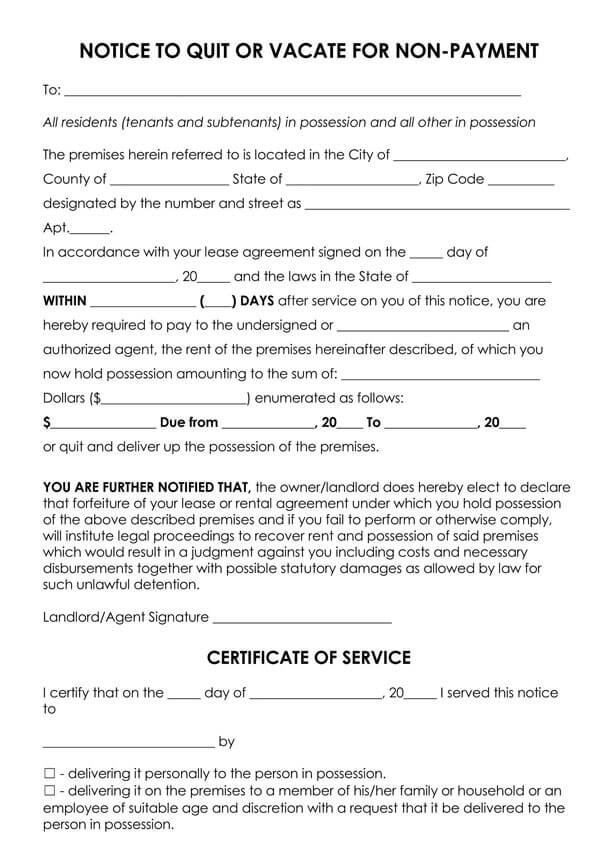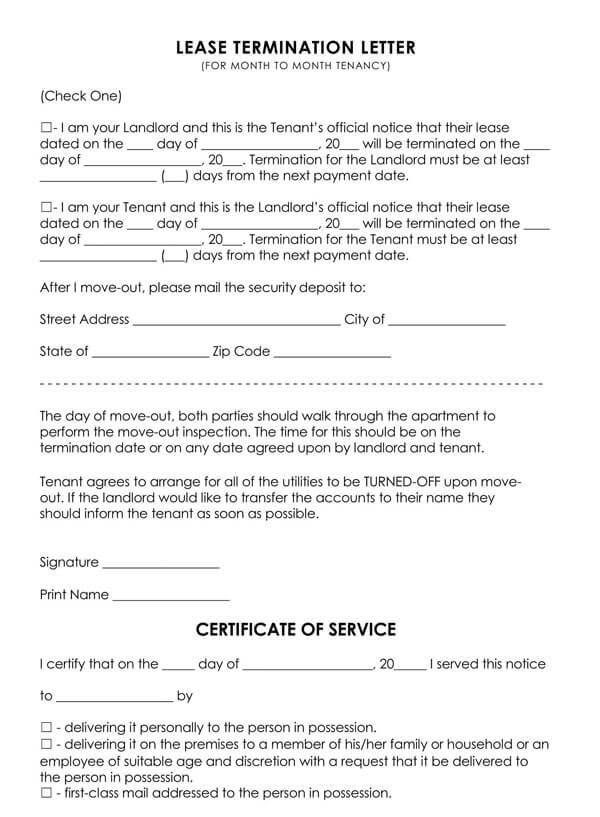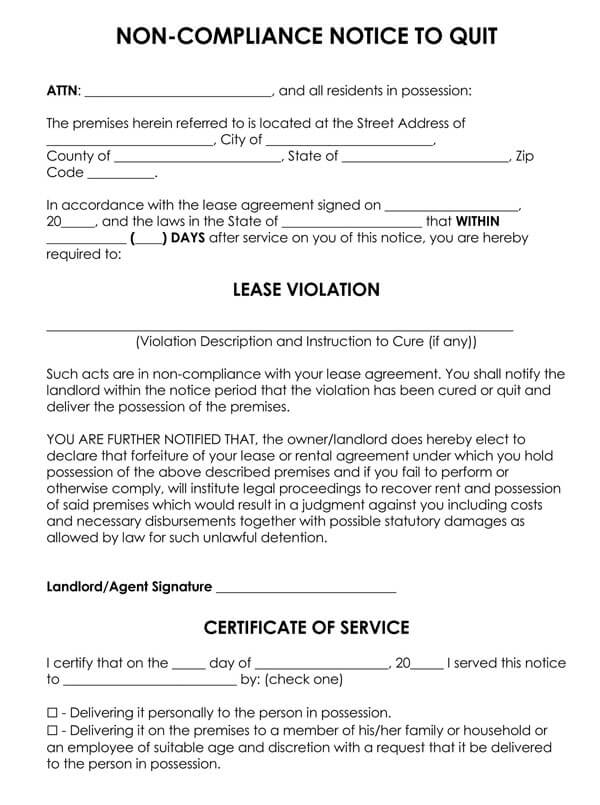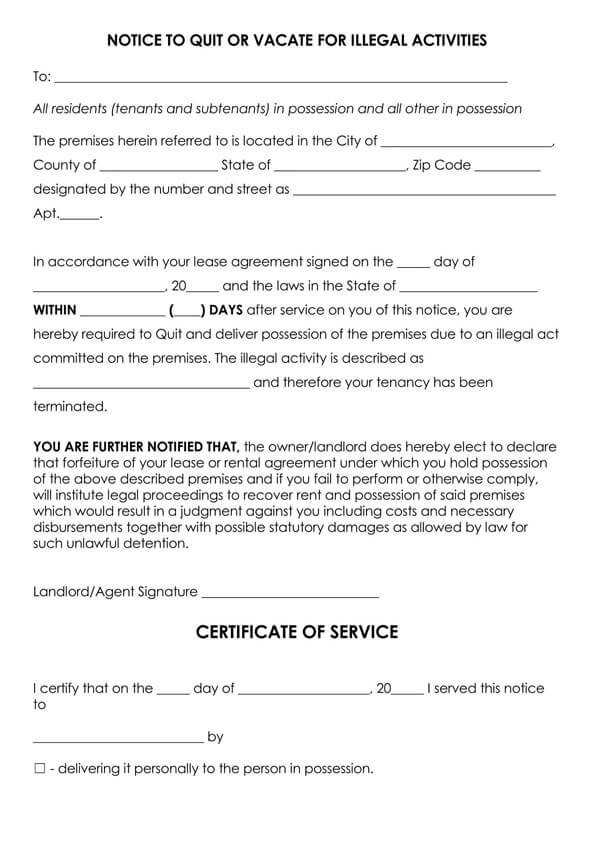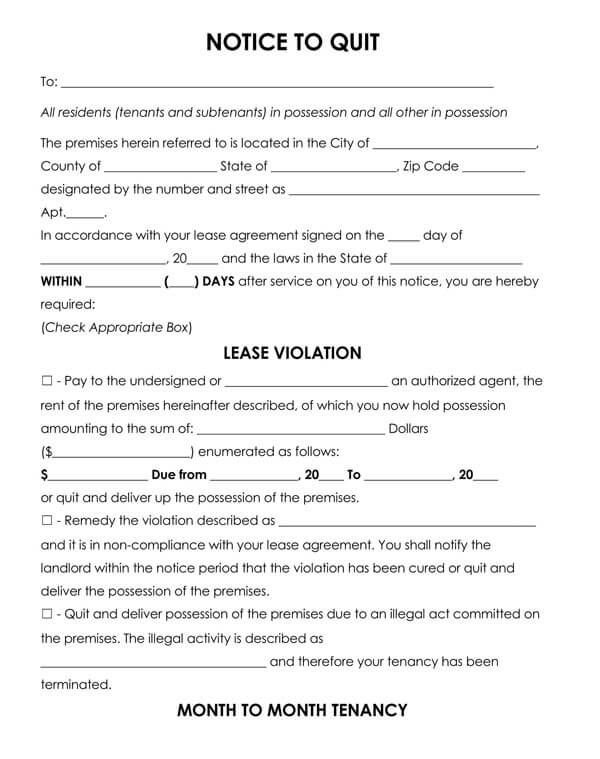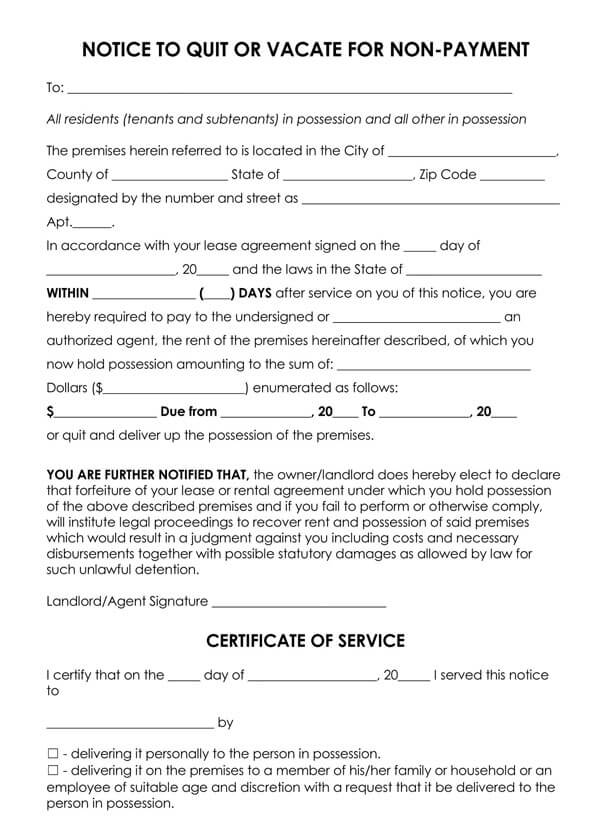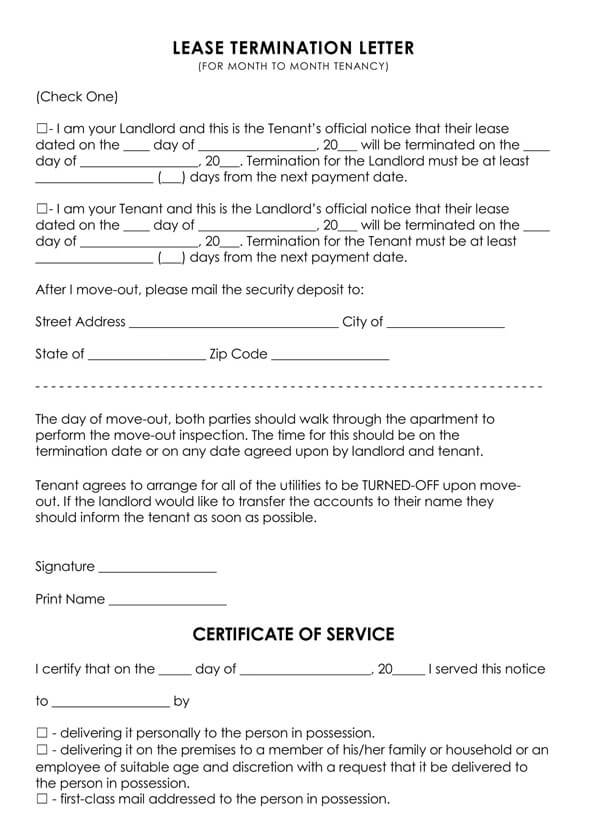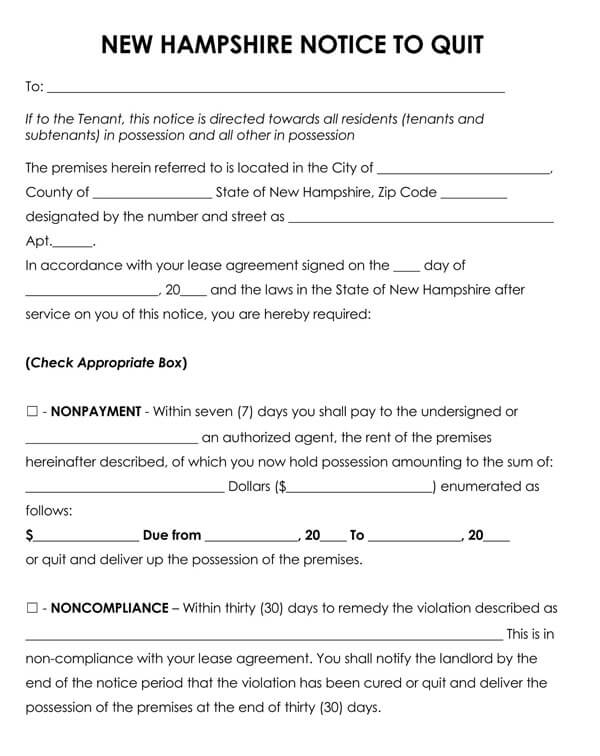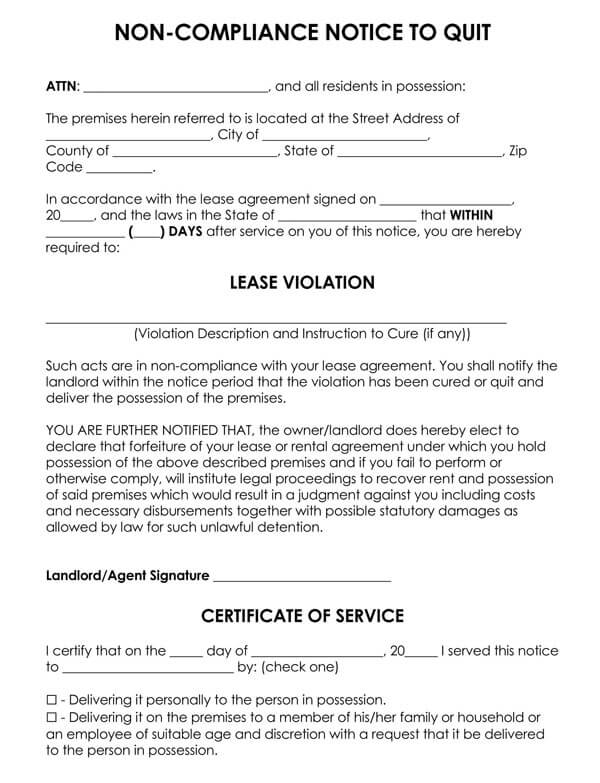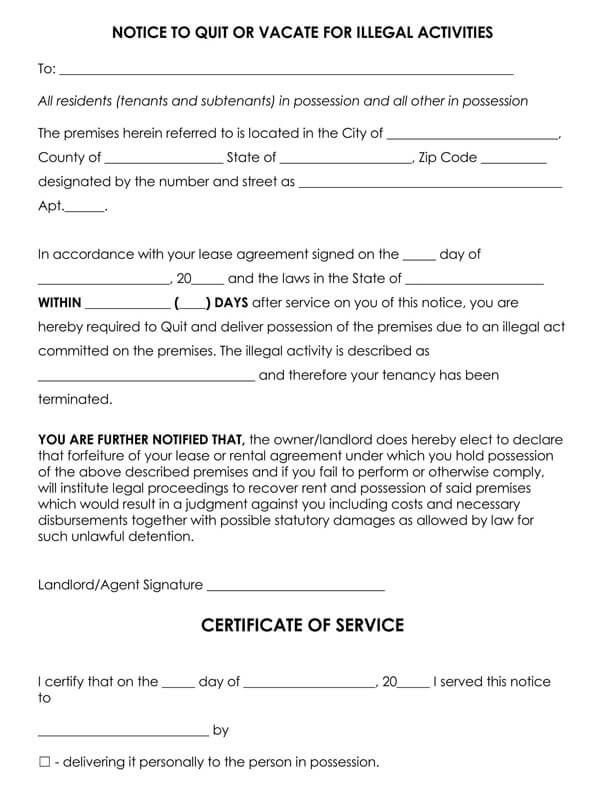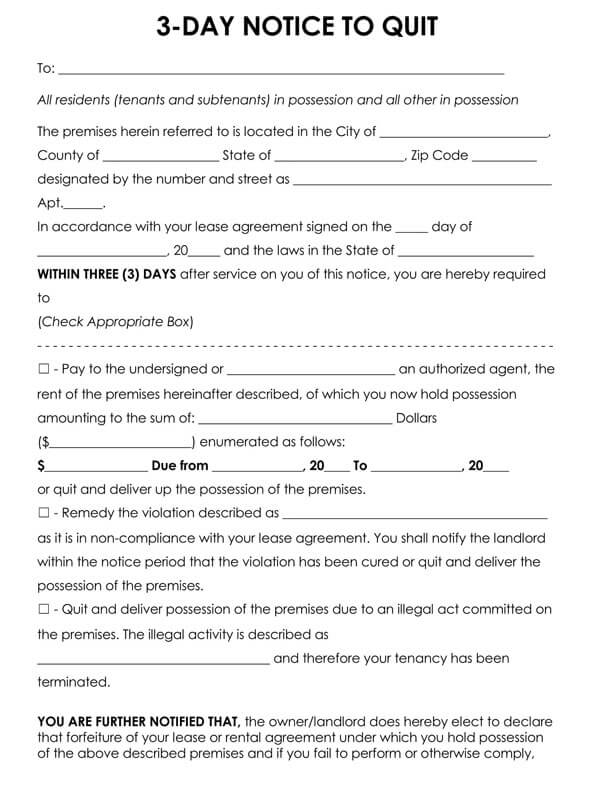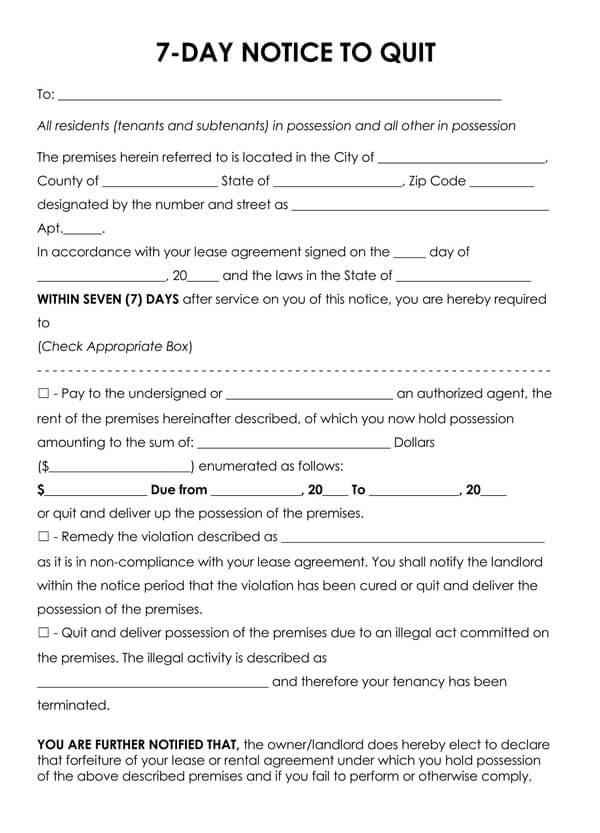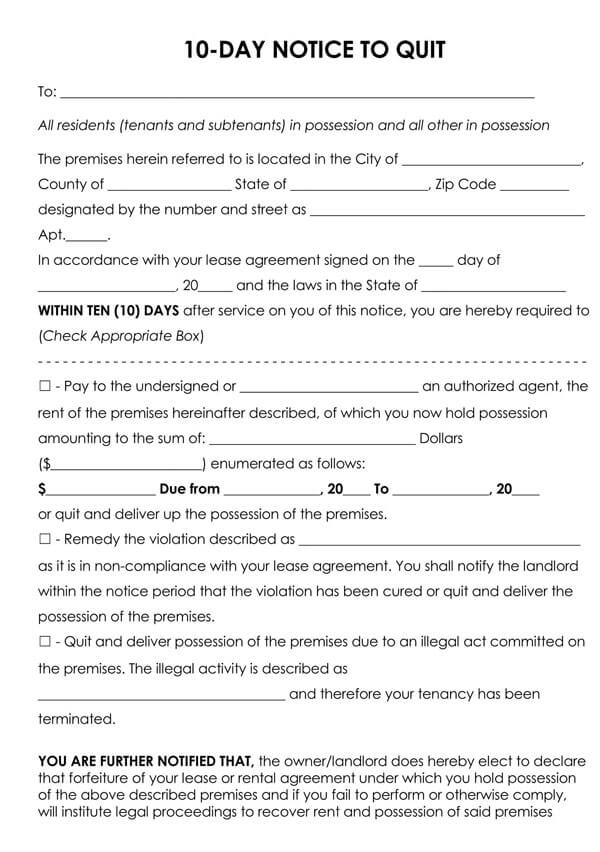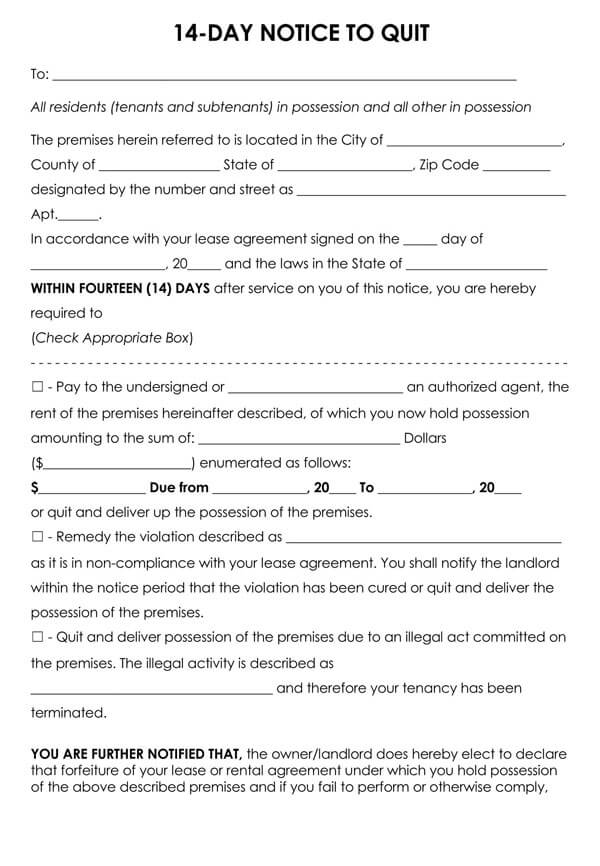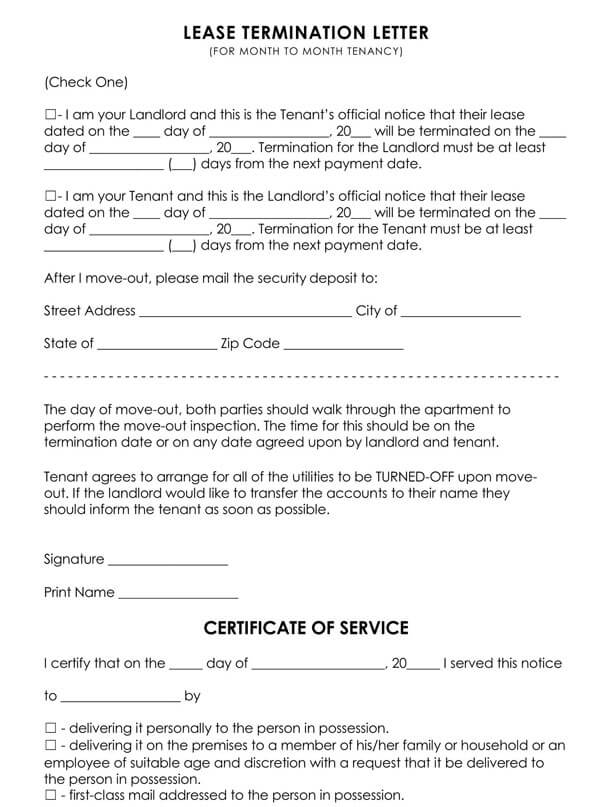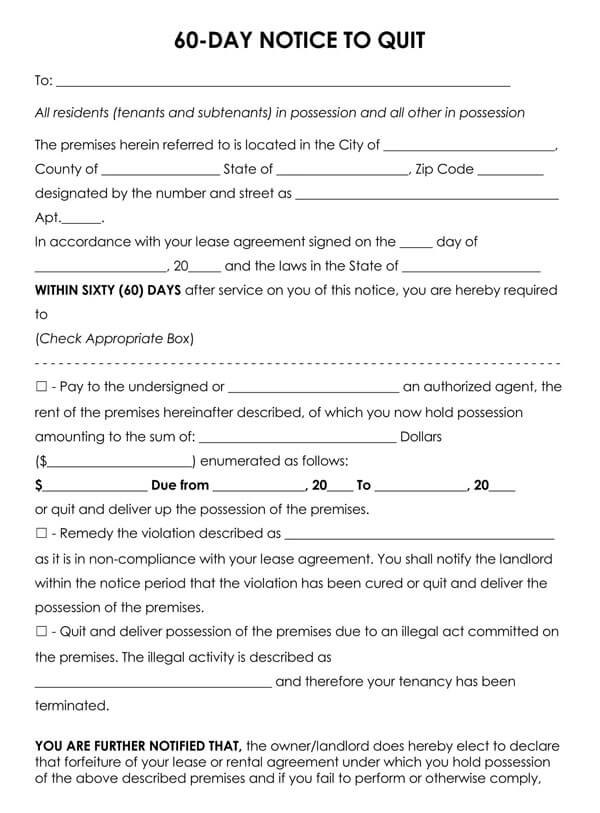An eviction notice form is also referred to as “notice to quit”, an eviction notice is a written notification sent by the landlord to a tenant, citing either violation or termination of the rental agreement. Once the tenant has received the eviction notice form, the tenant will have a specified period within which they comply or vacate the property.
As a landlord, some rare instances allow you to legally evict a tenant with immediate effect. This situation is known as “Eviction without Consideration”. You are still required to file a particular request for this type of eviction. A notice of eviction informs the tenant that they may need to go to court with the landlord to resolve or complete the eviction process.
Types of Eviction Notice Forms
Depending on the reason for eviction, an eviction notice form can carry other names.
There are three basic types of eviction notices;
Pay rent or quit notice
This eviction notice form is usually served when the tenant fails to pay rent. This eviction notice is generally subjective to the local housing laws in the state, but the average period of grace given to the tenant is 3 to 5 days. Most states require the landlord to give a minimum of 5 days’ grace to the tenant, while some require as little as three days’ notice. The landlord is required to give 7 days’ notice in only 6 states.
Only three states require 10 days’ notice and another three states require 14 days’ notice. A tenant can only enjoy 30 days’ notice in the District of Columbia. Six states in the US require that the landlord and tenant agree on notice requirements while drafting the rental agreement, and upon eviction, refer back to the original rental agreement.
Cure or quit notice
This type of eviction notice form is served when the tenant violates one of the terms of the original lease agreement. The violation may be small conflicts, such as having pets in a building where a no-pet policy is in place. Upon receipt of this eviction notice, the tenant is allowed a certain period during which they are to rectify the situation or leave the premises.
Just like a situation where the tenant fails to pay rent, situations that require a cure or quit notice depend on the state under which the property falls. As a result, different states vary on the length of the notice. Some States allow the tenant up to 30 days’ notice while other States allow only three days’ notice.
Note
A curable notice allows the tenant to rectify the situation by complying with terms specified by the landlord. An incurable notice on the other hand only specifies that the tenant vacates the property on or before a specified deadline.
Unconditional quit notice
This type of eviction notice form is also known as the “end month-to-month” notice. In this situation, the tenant is not required to pay rent or rectify any situations. The tenant is only required to vacate the premises within the specified period. This type of eviction notice form is usually used as a last resort when a tenant has on multiple occasions breached tenancy agreements, committed a crime on the premises, or seriously damaged the premises.
Two-thirds of the States require a 30-day eviction notice form while a couple of other States favor the tenant by requiring a 60 days’ notice. A few States require only 3 days’ notice and in Wyoming, the landlord is not required to give any advance notice.
Unconditional quit notices are usually used by landlords who have a tenant that has repeatedly violated the terms of the lease agreement or have failed to pay the rent at the due date on multiple occasions. Landlords may also use this eviction notice form if the tenant commits a gross violation of the terms of their lease.
To summarize, violations that typically justify an unconditional quit notice include:
- Serious property damage.
- Serious criminal activity on the property.
Notice Periods and Laws
Different states in the US have laws specifying the grace period for tenancy agreements. In the state of Alabama for instance, an eviction notice form and non-payment give the tenant 7-days’ notice, while in the state of West Virginia, the tenant is evicted with immediate notice. Non-compliance gives the tenant 10 days’ notice in the state of Alaska. However, in Kansas, the tenant can enjoy a 14-day notice for the same breach of contract. States like Kentucky handle eviction notice forms according to federal laws. While Minnesota does not have a specified Grace period for non-compliance.
States in which Eviction Notice is Commonly Used
These are the top 10 states in the country where eviction notice forms may be needed:
- Texas
- Pennsylvania
- Ohio
- North Carolina
- New York
- Michigan
- Illinois
- Georgia
- Florida
- California
Types of Eviction Notice (by Time Period)
The eviction notice form must also contain the lease and tenant information under consideration. The tenant information includes the tenant’s name, social security number, address, and phone number. The lease agreement by which the tenancy of the tenant was established should be referenced properly using adequate descriptions.
The types of eviction notice forms include:
Based on the state under which the property from which the tenant is to be evicted falls, and the circumstances resulting in the eviction, these are the types of eviction notice form a landlord may serve a tenant:
3-day notice: A 3-day eviction notice form mandates the tenant to vacate the premises in 3 days. The tenant may not stay past the third day after receiving the notice. If the 3-day notice is a curable notice, the tenant has three days to comply with the terms of the landlord or vacate the premises.
5-day notice: This eviction notice is served to notify the tenant that they are required to vacate the premises in 5 days or less.
7-day notice: This notification allows the tenant a period of seven days to vacate the premises or meet the landlord’s terms.
10-day notice: With this eviction notice form, the tenant has only 10 days to move out of the property.
14-day notice: A 14-day notice allows the tenant up to 14 days to move out of the property.
30-day notice: The tenant has 30 days to move out of the property or comply with the landlord’s terms in the case of a curable eviction notice.
60-day notice: Serving a tenant with this eviction notice form provides the tenant with a period of 60 days by which they should vacate the premises or rectify the situation in case of a curable instrument is.
Notice to comply or vacate (lease violation): This type of eviction notice form is served when the tenant violates one of the terms of the lease agreement. The tenant is given the choice to either comply with the terms of the agreement or vacate the premises.
Illegal activity: Upon discovery that the tenant is engaging in any illegal activity on the premises, an eviction notice stating thus may be presented to the tenant.
Lease termination (month-to-month lease): This type of eviction notice form is used when the tenant has a month-to-month lease agreement with the landlord. The landlord may use this eviction notice to terminate a month-to-month lease.
Since the period of time a tenant has to vacate the premises is dictated by the laws of the state under which the property Falls, it is best to discuss with an attorney to ensure that the eviction notice form is in line with the state law.
Components of an Eviction Notice Form
For an eviction notice to be valid it must contain the following components:
Landlord-tenant relationship
There should be a pre-existing landlord-tenant relationship that should be clearly stated in the eviction notice form. The landlord should be named as well as the tenant. The property under consideration should also be mentioned and adequately described.
The desire to terminate the tenancy
With a pre-existing landlord-tenant relationship, the landlord may express a desire to terminate the tenancy of the tenant. The landlord should state their desire to terminate the tenancy in clear terms.
Specify the reason for termination
The landlord is required to specify a valid reason for terminating the tenancy. The reason may include a failure to pay rent, property damage, criminal convictions, or any other valid reasons already discussed before in this article.
Lease and tenant information
The landlord should indicate that the lease agreement is a month-to-month tenancy and express their desire to terminate the month-to-month tenancy.
Month-to-month tenancy
The landlord should indicate that the lease agreement is a month-to-month tenancy and express their desire to terminate the month-to-month tenancy.
Certificate of service
The certificate of service for the duration should also be included and attached to the eviction notice form.
Lease expiry (Date)
The exact date that the lease has expired should be stated in the case of a lease expiry eviction notice form.
Where the eviction is occurring
The address of the property from which the landlord wishes to evict the tenant should be fully stated.
Solution of the issue (if any)
In the case of a curable eviction notice form, the landlord should reference the name and date of the original tenancy agreement and cite the violation. The landlord should state how the tenant can fulfill their promise according to the original agreement to resolve the eviction notice form.
Free Eviction Notice Templates
Filing an eviction notice form should be done in accordance with the local state laws relevant to the property in question. Also, the notice to quit should follow all appropriate legal channels and notify all relevant parties in order to be effective and efficient. This is why it is advisable to download a pre-written well researched and detailed eviction notice form template that fits your situation perfectly to protect yourself from unwanted costs and have the fastest possible eviction process.
Download our eviction notice form template according to your preference today.
Templates by Eviction Type
Templates by Eviction Period
Templates by State
Commonly Acceptable Reasons to Evict a Tenant
What’s best for most landlords is to avoid evicting a tenant. This is because the eviction process is a time-consuming and expensive ordeal.
However, these are the most common reasons why most landlords choose to evict their tenants.
Failure to pay rent: If the tenant refuses, or is unable to pay the rent as at when due, the landlord may serve an eviction notice form.
The tenant’s rejection: If for some reason, the landlord decides to change the amount of rent due on his property, as long as the change is not unreasonable, or excessive, the tenant is obligated to pay the new amount of risk facing an eviction notice form.
Criminal convictions of the tenant: If a tenant has been convicted of a crime, the landlord may serve an eviction notice form.
Violation of the lease: Violation of the lease agreements, such as property damage or noise complaints are very common reasons for serving an eviction notice form.
The lease expired: This eviction notice form title is used when the tenant stays past the expiry of their lease or after the lease is canceled or terminated.
End a month-to-month lease: This notice title is used when the landlord wants to end a month-to-month lease.
Unwanted roommate: This notice applies when the landlord does not want to continue living with a friend or family member of the tenant.
Other names for Eviction Process
The eviction process may also be described using the following terms:
- Eviction lawsuit
- Repossession
- Summary process
- Summary possession
- Ejectment
- Forcible detainer
- Unlawful detainer action (UDA or UD)
How to Evict a Tenant (In-depth)
Follow the steps below to legally evict a tenant from your property;
Step 1: Try to solve the violation
If you have a tenant that you need to be evicted from your property, the best course of action is to follow the legal approach in evicting them. As a landlord, you should never take matters into your own hands, either by changing the locks, or physically removing the tenant yourself, or getting someone to do it on your behalf.
You must never harass the tenant, or shut off the utilities.
The best course of action is to go through the court system, and each state has its own eviction laws. You also need a valid reason to evict the tenant such as violating lease terms, failure to pay rent, etc.
Whatever the violation, the first course of action is to attempt to resolve the violation and get both parties on the same page. Typically, most tenants go 6 months without ever being late on the rent or causing a nuisance. If a tenant can do this, such a tenant is regarded as a good tenant as opposed to a tenant that is always late on the rent and constitutes a nuisance regularly.
From the business standpoint, the landlord has to ensure that the rent is paid on time, every time and so, if late payment is a one-off, an amicable resolution is the best course of action. However, if the tenant continues to fall behind on payments or breach the terms of the lease agreement, then a landlord may have no other choice but to seek an eviction. It is always much better to make the tenant leave on their own accord without the landlord having to go to court.
Step 2: Send an eviction notice to the tenant
Officially, the eviction process starts when the eviction notice is delivered to the tenant. The eviction notice form, also known as a notice to quit should be delivered to the tenant by posting it to the tenant’s door, while simultaneously sending it by certified mail with a documented return receipt requested. Sending the notice to quit by the United States Postal Service serves as public documentation of the date the eviction notice was served.
As the landlord, It is important to ensure that you send the right type of eviction notice, providing your tenant with adequate time to vacate the premises. You need to ensure that the eviction notice is in line with your state laws, so it is best to confirm your state laws on your particular situation and file your eviction notice accordingly. The time frame on the eviction notice form should be calculated from the day the eviction notice is delivered.
Step 3: Wait to see if the violation is amended
Observe the tenant during the time frame to see if the tenant has amended the violation or is attempting to vacate the premises.
Step 4: File eviction papers with the courts
The most important thing is to follow the eviction laws in your state. If by the end of the notice period, the tenant has not secured the violation or vacated the premises, you may proceed to go to your local county courthouse and file a copy of the return receipt, officially filing for the eviction in the courthouse.
Step 5: The complaint usually must contain
Along with the return receipt of the initial eviction notice, you also need to provide the information at the courthouse to successfully file your eviction against the tenant.
The List of information includes:
- The address and description of the property on the question.
- A detailed reason for the eviction.
- A detailed account of the delivery of the eviction notice.
- Accounting information of all unpaid rent deals at the time of filing.
- If you seek attorney fees, you will need to include a statement with the filing.
Once you have filed the necessary documents and information the court will then serve a summons that orders the tenant to show up to court on a specified date.
Step 6: Go to court to prove your case against the tenant
If the tenant is unable to pay their rent on time, there is a good chance that the tenant will not be able to afford a lawyer. Also, evictions are a civil matter and the court will not assign a public defender to them. This leaves your tenant in a position where they have to defend themselves in court which makes the case easier for the landlord. As the landlord, you need to show up in court with all the documentation, including the original signed lease agreement, written notices, communication records, records of payment, and the notice to quit.
If the tenant wins and gets to stay on the property, the landlord may be required to pay the tenant court costs and attorney fees. It may be favorable to avoid an eviction and resolve the problems outside the court as the average cost to evict a tenant is estimated at around 10,000 dollars. This figure was estimated in an article by Cozy in the August 2015 edition of the landlord property management magazine for the San Francisco metro area.
Step 7: Move the tenant out
If the landlord wins the case, the court will allow the tenant a small time frame to enable them to pack up their personal effects and leave. Typically, the court may allow the tenant a week. If the tenant fails to move out at the end of the allotted time frame, the landlord may contact the local sheriff’s department. In a situation like this, the sheriff’s department will legally escort the tenant out of the property along with all their possessions.
The prevailing party is entitled to recover all court costs. Usually, the security deposit should be able to cover most of the losses incurred by the landlord. However, if the security deposit is not enough, the collection should be handled by going through a small claims court. The process may take a while depending on how much money is at stake, so it is advisable that you consider the worth of your time compared to the amount of money you are trying to recover.
Notice
If however, the tenant wins the case, you as the landlord would be covering the court costs and paying all necessary charges.
Step 8: In case the tenant wins
If the court rules in favor of the tenant, the landlord may be mandated to pay the tenant court costs. Court costs may include filing fees and attorney fees. It is important that you check the lease as the landlord to determine what you are liable for should the tenant win the case.
Illegal Self-Help Measures to Avoid
Your property is yours, and you do have rights that you may exercise. However, signing a lease to a tenant also provides them certain rights upon which you must never infringe otherwise, you may be faced with legal action.
As a landlord, you must not;
- Attach padlocks to the door.
- Change the locks.
- Remove doors or windows.
- Discontinue utilities such as electricity water or gas.
- Remove the tenant furniture.
- Physically remove the tenant or get someone to physically remove the tenant on your behalf.
- Intimidate or harass the tenant to move out.
As the landlord, you must use the court administrated eviction process at all times.
Considerable Judge Rules
The judge presiding over the eviction case may rule in favor of the landlord, or in favor of the tenant. If the judge rules in favor of the landlord, the judge will confirm the eviction. Should the judge rule in favor of the landlord, the tenant must vacate the premises on or before the assigned date as failure to vacate the premises means the sheriff department can legally escort them from the property, after which the locks may be changed by the landlord to prevent re-entry into the premises.
In the event that the judge rules in favor of the tenant, the tenant gets to stay in the residence and the landlord, depending on the lease agreement, may be mandated to pay the tenant’s court costs.
Methods of Delivering Eviction Notice
As a landlord, there are two ways to deliver an eviction notice to the tenant. These means of delivering an eviction notice to the tenant are based on the means of delivery only. It is important that the tenant receive the eviction notice, and the landlords should be able to prove that the tenant received the eviction notice with dates.
Personal delivery to tenant
This involves the landlord personally handing over the eviction notice to the tenant. By so doing the landlord is certain of the receipt of the notice.
Personal delivery to the property
In a situation where the tenant is unavailable or the whereabouts of the tenant are unknown, the landlord may deliver the eviction notice to the property. We strongly recommend that as the landlord, you should send the eviction notice form by certified mail return receipt or deliver the notice to the property by hand so as to have proof of the tenant’s receipt of the eviction notice.
Why it is Necessary to Send an Eviction Notice Form?
We live in a society where laws were made to maintain order. No tenant should have to find themselves in the insecure position of being homeless without any warning. On the other hand, all landlords should receive timely and adequate payment for leasing their property.
Laws have been put in place to protect both the interests of the landlord and tenants, and these statutory procedures are detailed and thorough with penalties for either party that tries to deny or infringe upon the rights of the other.
Failure to send out a notice prevents you from beginning the process of evicting a tenant from your property as far as the law is concerned.
Landlords 4 Areas of Preventable Costs
There are a few occurrences that will possibly arise during the process of eviction. You must keep them in consideration while keeping the financial aspect and other aspects of the process concerned to you directly.
These considerations include;
Pay for damages incurred by the tenant
The landlord will be required to pay for damages incurred by the tenant as a result of being unlawfully evicted. The costs include expenses of finding temporary housing, replacing damaged belongings, and attorney fees to defend against unlawful eviction.
Pay penalties
The landlord will also be required to pay penalties depending on the state laws in question. Some States can mandate the landlord to pay up to $100 for every day of unlawful self-help.
Personal and work time to attend court
The landlord would have to sacrifice their personal time as well as work time to attend court. The landlord would have to postpone or neglect other more lucrative endeavors to attend the court proceedings.
Mental anguish and torture
The landlord will also have to endure the mental anguish of having an unprofitable piece of property and suffer the torture of a delayed eviction process.
Tips to Avoid Eviction Costs in the Long-Run
There are a few ways that you can avoid eviction costs in the long run. These few tactics include;
Avoid unnecessary eviction cost: To avoid unnecessary eviction costs as the landlord, you should use specific forms to notify the tenant and document copies of all the forms.
Rental Application: Use a rental application form to find a hassle-free tenant and confirm relevant information about them such as;
- Credit scores
- Background check
- Work status
- Current financial standing
References: References from past landlords and property managers.
Late rent notice: Used a late rent notice to document each time the tenant does not pay the rent on time.
Notice of lease violation: Use the notice of lease violation to get the tenant to rectify a lease violation situation, and document every lease violation.
Notice of termination: Use a notice of termination to notify the tenant that the lease will not be renewed.
Notice of rent increase: Use a notice of rent increase to notify the tenant of an impending increase in the rent.
Landlord’s notice to enter: Use a landlord’s notice to enter to notify the tenant in advance in the case of an inspection. Inspection may be to:
Tenant’s compliance: Check the tenant’s compliance with the lease agreement.
Inspect the property: Inspect the property for maintenance purposes such as heating and painting. However, this notice is not required if there is an emergency like a burst pipe or fire.
Notice of rent increase: Use a Notice of rent increase to warning the tenant of a lawful and reasonable increase in rent.
Remember
Eviction notices are used all over the United States, but the occurrence of eviction notices is more frequent in some States than others.
Evicting a tenant may be a straightforward process or a long and expensive one depending on the approach you take. It is important that you do everything according to the law to avoid unwanted costs and penalties. With the right of eviction notice form that conforms to the local laws of your state, you can lawfully evict any tenant without acquiring excessive costs in the process. Download our detailed and well-researched fiction notice template right away to begin
Frequently Asked Questions
How long does an eviction take?
As a landlord, you can legally evict a tenant from the first day you send a notice to quit. However, it may take until the court passes judgment which can take anything from a month to three months if the tenant chooses to hold out.
What is an unlawful detainer?
Also known as a “forcible entry and detainer”, unlawful detainer is the legal term for the court proceeding involved in evicting a tenant. The term eviction is the broader sense which describes a situation when the landlord brings the case against a tenant to obtain a court order which allows the landlord to legally obtain procession of their property from the tenant.
Are all evictions lawful?
The simple answer is no. However, since many states have different state laws regarding the matter, unlawful eviction in one state may be unlawful in another, so it is important to be clear on the state laws in your local area to determine the legality of your eviction.
How does an eviction notice become legally enforceable?
A hand-delivered eviction notice, by itself, is not legally enforceable. However, if the landlord can verify that the tenant read and understood the eviction notice, it can be used in an eviction court case. This is why it is important that the eviction notice contain a statement stating that the tenant has read and understood the information contained in the notice with space for the tenant to affix their signature and date.
